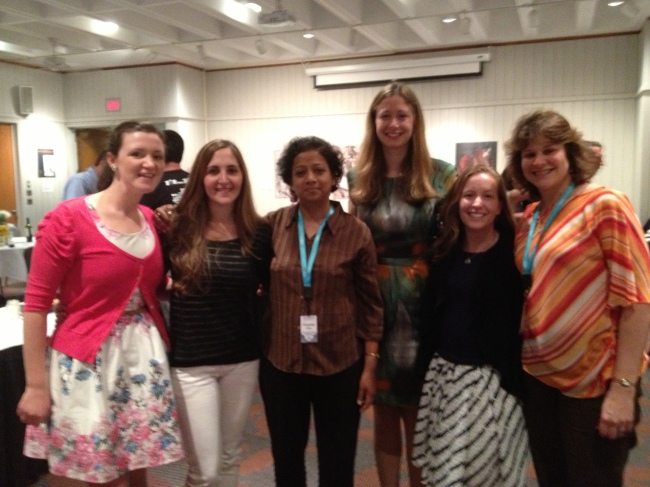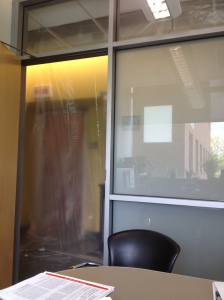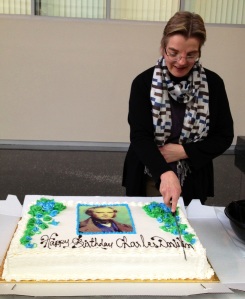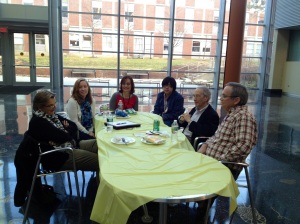But, I sure do have a ways to go.
Today is my 1-year anniversary of being an RU prof. Wow, time flies when you are working your butt off! While taking some holiday time off, I’ve been reflecting upon this past year- what’s happened, what I’d like to improve and where I’d like to see things go in 2013. Here’s how I see it.
Money
I don’t have the hard numbers in front of me, but I think I’m doing okay in this department. That certainly doesn’t mean that I’m rolling in dough, and I still need to figure out ways to pinch pennies. We have figured out a couple of things to make our supplies stretch further.
One simple change that we made is doubling-up on the number of cover slips that we use to mount our cells onto microscope slides. This means that we cut our slide usage in half for each experiment. These suckers are expensive, so this made me really happy!

When we apply our coverslips to our samples, we have to be really careful to not crush our round, plump cells. To do this, we balance a slip onto the end of a syringe needle and slowly lower it. Instead of opening a new syringe every time we are prepping our samples, we now keep and reuse the syringes (safely, I should add).
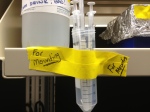
We also found a company called BullDog Bio that has really great deals on a lot of reagents that are quite expensive from other companies. One of my favorites is their PCR beads. $60 for 96 tubes containing freeze-dried PCR mix is really a pretty good deal and cuts down on the time it takes for genotyping. Plus, the packaging is kinda sexy- check it out for a chuckle!
Grants
This goes hand-in-hand with the money section, but deserves it’s own heading. So far, we are operating on start-up funds and the NIH R00. For year 2 of the R00, it looks like there’s a budget cut. Lovely. I submitted 3 grants in 2012. One was not funded and I will find out about the other 2 sometime this spring.
2013 is going to be challenging. I’ll probably submit 2 smaller grants in the next few months and then focus on gearing up to write and submit my first R01 (eep!) for the October submission. This is the big time, must have grant if I want to even think about getting tenure here. And, it’s going to be a tough battle. Luckily, I’m still in the new investigator category, which has better paylines than the rest of the folks.
Papers
In 2012, I finished publishing my postdoc work. One manuscript was my Aurora kinase C paper that made the August cover of PNAS. The other was a collaborative project with Jeong Su Oh, a post-doc at UCSF in Marco Conti’s lab. This manuscript was recently accepted but it is not in print yet, so stay tuned.
This year, I hope to write at least 1 report on our on-going work. One of my postdocs has a good story brewing and he is working ridiculously hard to finish it. My only fear is being confident about when a story is ready for submission. Not having that senior person above you reassuring you that you have a publishable product is scary. But, I do think that if I could get a publication out before submitting the R01, I’d really increase my chances of getting funded. So, I’m not going to waste time.
Teaching/mentoring
I had a full year of “teaching release” to get my research up and running, so I haven’t had to do much formal teaching yet. This semester I’ll be team teaching the Genetic’s Honors seminar course with Jin Xing and starting to put together my course for the fall on the “Ethical, legal and societal implications of genetic technologies.” Ideas and guest lecturing volunteers are welcomed!
I’ve had many undergrads through the lab this year, and with mixed results. I’ve been trying different things to make the mentoring process more streamlined but haven’t quite figured out the best methods. This semester I decided to draw up a student contract, because my rules and regulations seem to be forgotten over the course of a semester and then I simply get annoyed. I know this may come across as a hard-ass, but really, I’m saving myself angst and frustration, and making sure that my expectations are crystal clear. There should be no surprises! Hopefully this will work, what do you think?
Schindler Lab Student Contract 2013
Service
Part of getting tenure entails doing “service,” aka committee work. I’ve been told to be very careful about which committees to serve on and try to get on those that have don’t take up too much of your time. As of now, I’m on our departmental seminar committee (an easy one and a great way to network) and on the MBS grad school admissions committee (a bit more time consuming, but only meets for a short amount of time of the year). I don’t foresee any changes in 2013.
That’s it in a nutshell. It’s going to be a busy 2013, but hopefully I’ll have a few minutes to keep you updated!
Happy New Year!
